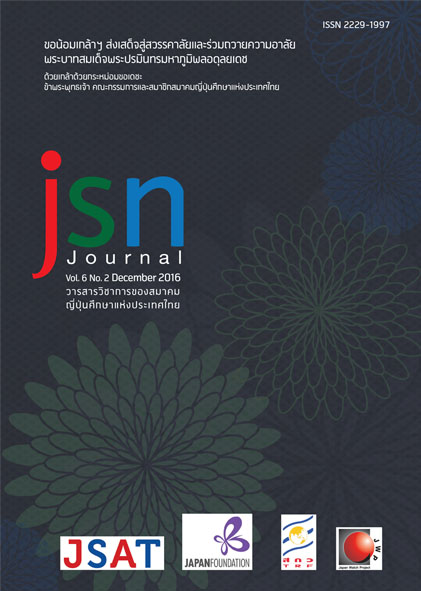The Equal Employment Opportunity Law of Japan: Three Decades of Changes
Main Article Content
Abstract
The Equal Employment Opportunity Law (EEOL) of Japan was adopted on April 1, 1986 following Japan’s signatory to the Convention on the Elimination of All Forms of Discrimination against Women (CEDAW) in 1981 and its ensuing ratification in 1985. In the three decades since the law was put into effect, the EEOL has undergone three amendments - in 1997, 2006 and 2013, each having an approximate 10-year span to the next.
This article examines the evolution of the EEOL, beginning with its development, leading to the enactment of the original EEOL, to the major issues and controversies that have spawned debates leading up to each revision. Based on primary sources and relevant literature, the results showed that even women themselves have questioned the viability of the notion of equality under the law. Nevertheless, this study shows the dynamism of the approach to creating equality in the context of employment in Japanese society.
Article Details
ข้อความและข้อคิดเห็นต่างๆ ในบทความเป็นของผู้เขียนบทความนั้นๆ ไม่ใช่ความเห็นของกองบรรณาธิการหรือของวารสาร jsn Journal
References
Asia-Pacific Human Rights Information Center. (2006). Amendments to the Equal Employment Opportunity Law Passed the Diet. Retrieved from http://www.hurights.or.jp/archives/newsinbrief-en/section2/2006/06/amendments-to-the-equal-employment-opportunity-law-passed-the-diet.html
Boling, P. (1998). Family policy in Japan. Journal of Social Policy, 27(02), 173-190.
CNN.co.jp. (2013) 「「ウーマノミクス」は日本を救うか 安倍政権が女性活躍を後押し」 Retrieved from http://www.cnn.co.jp/business/35032452.html
Edwards, L. N., & Pasquale, M. K. (2003). Women’s higher education in Japan: Family background, economic factors, and the Equal Employment Opportunity Law. Journal of the Japanese and International Economies, 17(1), 1-32.
Fan, J. S. (1999). From office ladies to women warriors: the effect of the EEOL on Japanese women. UCLA Women’s Law Journal, 10(1), 103-140.
Hanami, T. (2000). Equal employment revisited. Japan Labor Bulletin, 39(1), 8-17.
Knapp, K. K. (1995). Still office flowers: Japanese women betrayed by the Equal Employment Opportunity Law. Harvard Women’s Law Journal, 18, 83-122.
Ministry of Justice. (2009, April 1). Civil Code (Part I, Part II, and Part III). Retrieved fromhttp://www.japaneselawtranslation.go.jp/law/detail/?id=2057&vm=04&re=02&new=1
Ministry of Justice. (2014a, February 10). Ordinance for enforcement of the Act on Ensuring Equal Opportunities for and Treatment of Men and Women in Employment. Retrieved from http://www.japaneselawtranslation.go.jp/law/detail/? re=02&dn=1&x=47&y=13&co=1&ia=03&yo=&gn=&sy=&ht=&no=&bu=2048&ta=h0&ty[]=C&ky=&page=5
Ministry of Justice. (2014b, February 10). Guidelines on ways for employers to take appropriate measures with regard to items stipulated in the provisions concerning the prohibition of discrimination against workers on the basis of sex, etc. Retrieved from Japanese Law Translation Database System:http://www.japaneselawtranslation.go.jp/common/data/notice/122220.html
Ministry of Health, Labour and Welfare (2013). 「今後の男女雇用機会均等対策について(報告)」. Retrieved from http://www.mhlw.go.jp/file/05-Shingikai-12602000-Seisakutoukatsukan-Sanjikanshitsu_Roudouseisakutantou/0000024457.pdf
Ministry of Health, Labour and Welfare (2014).「男女雇用機会均等法令の見直しについて」. Retrieved from http://www.mhlw.go.jp/file/06-Seisakujouhou-11900000-Koyoukintoujidoukateikyoku/ gaiyou_4.pdf
Ministry of Health, Labour and Welfare (2016). 「ポジティブ・アクションは、なぜ必要?」Retrieved from http://www.positiveaction.jp/ 06/06_01.html
Nakamura, A. (2006, March 9). Working women still battle bias. The Japan Times. Retrieved from http://www.japantimes.co.jp/news/2006/03/09/national/working-women-still-battle-bias/#.VcLxClPAwo0.
Nakano, M. (1996). Ten Years under the Equal Employment Opportunity Law. In Voices from the Japanese Women’s Movement, 65-81. Armonk, N.Y: M.E. Sharpe.
Osaki, T. (2015, June 24). ‘Maternity Harassment’ victims assail lack of protection for pregnant working women. The Japan Times. Retrieved from http://www.japantimes.co.jp/news/2015/06/24/national/maternity-harassment-victims-assail-lack-of-protection-for-pregnant-working-women/#.VfKL71PAwo0
Ozawa, H. (2006, June 15). Japan tightens laws against sex discrimination. Agence France Presse.
Parkinson, L. (1989, April). Japan’s Equal Employment Opportunity Law: An Alternative Approach to Social Change, Columbia Law Review, 89(3), 604-661.
Shimoda, G. T. (2002). Japan’s new Equal Employment Opportunity Law: combating sexual harassment in the workplace. Transnational Law, 16, 215-247.
Shioda, J. (Producer), Yoshimine, M. (Director). (2015). 「第2回 男女共同参画社会~女たちは平等をめざす~」 [Television broadcast]. Japan: NHK (Japan Broadcasting Corporation).
Starich, M. L. (2007, March). The 2006 revisions to Japan’s Equal Opportunity Employment Law: a narrow approach to a pervasive problem. Pacific Rim Law & Policy Journal, 16(2), 551-578.
Sugeno, K. (2002). Japanese employment and labor law. (L. Kanowitz, Trans.). Durham, N.C.: Carolina Academic Press. (Original work published 1992).
U.N. (2003). Report of the Committee on the Elimination of Discrimination against Women, 29th Sess., Supp. No. 38, U.N. Doc. A/58/38. Retrieved from http://daccess-dds-ny.un.org/doc/UNDOC/GEN/N03/468/20/PDF/N0346820.pdf?OpenElement
Upham, F. K. (1987). Law and social change in postwar Japan. Cambridge, Mass.: Harvard University Press.
Weathers, C. (2005, October 3). Equal Opportunity for Japanese Women – What Progress? Retrieved from The Asia-Pacific Journal: Japan Focus: http://japanfocus.org/-charles-weathers/2012/article.html
Yamakawa, R. (2001). Labor law reform in Japan: A response to recent socio-economic changes. American Journal of Comparative Law, 49(4), 627-632.
石井淳子. (2006).「 改正男女雇用機会均等法の解説──雇用管理見直しの契機となることを期待厚生労働省雇用均等・児童家庭局雇用均等政策課長」NBL no.837(2006.7.15).
บารนี บุญทรง. (2545). การศึกษาบทบาทและหน้าที่ของผู้หญิงทำงานในสังคมญี่ปุ่นตั้งแต่หลังสงครามโลกครั้งที่สอง. (วิทยานิพนธ์ปริญญามหาบัณฑิต). มหาวิทยาลัยธรรมศาสตร์, คณะศิลปศาสตร์, สาขาญี่ปุ่นศึกษา.


